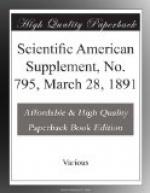The fact that the sick chickens disliked the nitrogenous ration, and since the first period the amount of food eaten by the hens and chickens of Lot I had continually decreased, led to the belief that their food might be too nitrogenous, and as during the last days of the third period one of the hens in Lot I was also ill, it was decided to discontinue the use of cotton seed meal and to use linseed meal instead. The hen recovered soon after the change in food.
The supply of skim milk running short in the last two periods, water was used instead in mixing the ration of the lots fed nitrogenous food.
At the beginning of the fifth period one-half of the linseed meal in the ration of Lot I was removed, and cotton seed meal substituted. This combination seemed a happy one, for on this ration both hens and chickens made large gains.
At the end of the experiment little difference could be seen in the hens of the two groups; but the two lots of chickens were in striking contrast. While the chickens fed on nitrogenous food were large, plump, healthy, active, and well feathered, the chickens fed on a carbonaceous ration were in general much smaller, sickly, and in several cases almost destitute of feathers. Two of them had perfectly bare backs, and so ravenous were they for flesh and blood that they began eating one another.
The inability of the chickens fed on a carbonaceous diet to throw out new feathers and the ability of the chickens fed on a nitrogenous diet to grow an enormous coat of feathers is a splendid illustration of the effect of the composition of the food in supplying certain requirements of animal growth. It was plain to see that maize, even when assisted by a small amount of wheat and green clover, could not supply sufficient nitrogen for the growth of feathers.
It will thus be seen that while both lots of hens lost weight during the experiment, the loss was slightly greater with those fed nitrogenous food, but these produced by far the most eggs.
The chickens fed on nitrogenous food just about doubled in weight, while those fed carbonaceous food only added about one-third to their weight.




